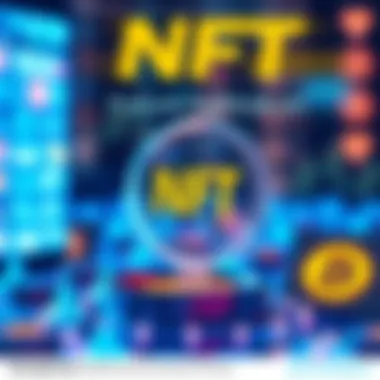Navigating the Evolving World of NFTs: Insights and Future


Intro
The world of Non-Fungible Tokens, or NFTs, has stirred quite a debate and curiosity among both seasoned investors and curious newcomers alike. What began as a niche area within the vast realm of cryptocurrency has evolved into a vibrant marketplace that crosses boundaries—from digital art to virtual real estate. As we navigate through this complex ecosystem, it is essential to grasp the foundational concepts underlying NFTs and the broader cryptocurrency landscape that gives rise to them. This understanding lays the groundwork for exploring the various trends, implications, and future forecasting related to this exciting technology.
Understanding Cryptocurrency Concepts
Blockchain Technology Explained
At the heart of NFTs lies blockchain technology. Simply put, a blockchain is a decentralized and distributed ledger that records transactions across multiple computers. This structure ensures that transactions are secure, transparent, and, most importantly, immutable. There’s no single point of failure, which makes it highly resilient against fraud. For NFTs, the blockchain acts as a ledger that verifies the ownership and authenticity of each token, which is key, especially in the art and collectibles space where provenance matters.
NFTs leverage different types of blockchains, with Ethereum being the most popular because it supports smart contracts—automatically executing contracts when conditions are met. This is crucial for NFTs since it allows for unique digital tokens to be created and traded in a manner that guarantees their scarcity and authenticity.
Key Terms Every Investor Should Know
Understanding a few key terms can significantly enhance your comprehension of NFTs:
- Minting: The process of creating a new NFT on a blockchain.
- Gas Fees: Transaction fees that must be paid in order to conduct transactions on the Ethereum network, particularly when minting or trading NFTs.
- Royalties: Some NFTs contain built-in royalties, allowing creators to earn a percentage on subsequent sales.
- Interoperability: The ability of different platforms and blockchains to interact and share data.
Ensuring you're familiar with these terms can provide a level of preparedness when diving into the NFT market.
Market Analysis and Trends
Current Market Trends in Cryptocurrency
The NFT market has seen explosive growth over the past few years. What started off slowly has transformed into a billion-dollar industry, indicating that digital ownership is more than just a passing trend. High-profile sales, such as Beeple's artwork selling for $69 million, exemplify the potential financial rewards that can come from investing in NFTs. Furthermore, niches like gaming and virtual reality are pushing NFTs into new realms, adding utility beyond mere collectibles.
Current trends suggest a diversification in NFT applications. Artists, musicians, and even sports leagues are tapping into this technology to connect directly with fans and monetize their creations. Additionally, as brands explore unique ways to engage audiences—like Nike filing trademark applications for digital shoes—it’s evident that the landscape will continue to evolve.
Investment Strategies for Different Market Conditions
Investing in NFTs isn't just about making quick flips. It requires a keen eye and understanding of market dynamics. Consider these strategies:
- Research-driven approach: Before diving into any NFT purchase, conduct thorough research to understand the artist, project, and potential demand.
- Diversification: Just like traditional investing, diversifying your NFT portfolio can mitigate risks. Don't put all your eggs in one basket.
- Getting involved with communities: Engaging with creators and collectors on platforms like Discord or Reddit can offer insights and opportunities that may not be readily available elsewhere.
As the saying goes, “Don't put the cart before the horse.” Understand the fundamentals before investing your hard-earned cash into the NFT space.
NFTs undoubtedly represent a shift in how we perceive ownership and investments. As we dissect the implications and forecast future trends in this article, we will paint a clearer picture of what lies ahead in the NFT landscape.
Preamble to NFTs
As we step into the complex world of Non-Fungible Tokens (NFTs), understanding their role is vital. These digital assets have gained substantial attention, revolutionizing various sectors, especially art and entertainment. By grasping the concept of NFTs, investors, traders, and enthusiasts can navigate the ever-evolving landscape that these tokens inhabit.
The Essence of Non-Fungible Tokens
At their core, NFTs represent digital ownership of unique items, often based on blockchain technology. Unlike cryptocurrencies such as Bitcoin or Ethereum, which are fungible and can be exchanged for one another, NFTs are one-of-a-kind. Each token carries distinct information and attributes that validate its authenticity and ownership. For instance, an NFT that represents a digital artwork contains data that distinguishes it from every other token, thus making it irreplaceable. This uniqueness makes NFTs particularly appealing in areas requiring provenance and exclusivity.
A notable example is the digital artist Beeple’s piece, "Everydays: The First 5000 Days," which sold for a staggering $69 million at auction. This sale sparked conversations across various sectors, highlighting not just the financial potential of NFTs but also their cultural significance.
One benefit of NFTs is the ability to provide artists with direct revenue streams. Instead of relying solely on galleries or traditional distribution methods, creators can sell their work directly to collectors, often at higher prices. Additionally, smart contracts allow artists to receive royalties from secondary sales, ensuring they continue to profit from their work even after initial transactions.
The implications of embracing NFTs stretch beyond art. They possess potential in areas such as real estate, gaming, and music. For example, in gaming, players can own exclusive items, skins, or characters as NFTs, creating an economy where users trade and enhance their experiences.
Distinction from Traditional Cryptocurrency
While traditional cryptocurrencies serve as mediums of exchange, NFTs provide ownership of specific digital or physical items. A straightforward comparison illustrates this: when you purchase Bitcoin, you're acquiring a unit of value – that is equal to any other Bitcoin. On the flip side, buying an NFT means you're obtaining something unique – like a limited-edition concert ticket or an original piece of digital art.
Furthermore, NFTs enable the creation of a thriving community around digital assets. Fans and collectors engage in exchanges, discussions, and transactions that deepen their connections to the works they admire. This interaction fosters a dynamic environment where both creators and collectors engage in a dialogue about value, creativity, and ownership.
In essence, NFTs mark a significant shift in how we conceive of value, ownership, and creativity in the digital age. As we proceed further in this exploration, it’s essential to acknowledge the transformations NFTs are initiating across multiple domains, pushing the boundaries of what we perceive as collectible and tradable in today's society.
Historical Context of NFTs


Understanding the historical context of Non-Fungible Tokens (NFTs) is pivotal for anyone looking to grasp their significance in the digital landscape. It's essential for investors, traders, and really anyone interested in the evolution of digital ownership. The trajectory of NFTs encapsulates key moments in technology and culture, weaving a narrative that reflects broader shifts in how we perceive value and ownership in the digital age.
The journey of NFTs marks the evolution of digital ownership from abstract concepts to concrete assets that can be created, sold, and traded. Recognizing how these tokens emerged clarifies their current usage and future potential, allowing individuals to make informed decisions about their investments and participation in the market. Understanding this context isn’t just academic; it has real implications for various stakeholders, including artists, collectors, and platforms that facilitate NFT transactions.
Early Developments in Digital Ownership
In the early days of the internet, the concept of digital ownership was quite nebulous. The advent of digital art and online content brought about new ways of creating and sharing, but ownership remained a gray area. Artists and creators often relinquished control over their work in exchange for visibility and engagement on various platforms.
The early developments can be traced back to initiatives like Napster, which revolutionized how digital media was distributed, but also sparked discussions about intellectual property rights. You may have noticed that these conversations bubbled to the surface nearly two decades ago. Various attempts to establish frameworks for digital ownership paved the way for NFTs, recognizing the value of unique digital assets much like traditional real estate or collectibles.
The digital scarcity argument gained traction as artists began to seek better ways to monetize their work without losing control over it. This was a crucial turning point. With the emergence of blockchain technology, the groundwork was laid for a decentralized method to verify ownership, leading to what we know today as NFTs.
The Birth of NFTs
The birth of NFTs fundamentally altered the landscape of digital ownership. It’s like someone flipped on a light switch in a dark room. The first instances of NFTs can be pinpointed to 2017 with the launch of CryptoPunks and CryptoKitties. These projects captured public imagination and showcased the potential for unique digital collectibles.
CryptoPunks, a series of 10,000 unique 24x24 pixel art characters, became a cultural phenomenon. With their distinctive traits and limited supply, these punks ignited interest among tech enthusiasts and collectors alike. Meanwhile, CryptoKitties allowed users to breed, buy, and sell virtual cats, introducing a playful dimension to the NFT landscape.
As these projects gained traction, it became clear that NFTs held more than just artistic value; they also represented a way to establish identity in the digital realm. This was a major milestone. The combination of smart contracts and blockchain technology eliminated the need for intermediaries, empowering users while also creating new opportunities and challenges alike.
“NFTs are to digital assets what signatures are to art—they prove authenticity and ownership.”
To summarize, the historical context surrounding NFTs is rich and multifaceted. Early developments provided the foundation for digital ownership discussions, while the birth of NFTs catalyzed a new era of asset ownership that remains ever-evolving. Understanding these elements is crucial for anyone involved in or considering engagement with NFTs, as they navigate a complex, yet fascinating landscape.
Mechanics Behind NFTs
Understanding the mechanics behind Non-Fungible Tokens (NFTs) is vital for grasping their significance in the digital landscape. NFTs not only represent ownership but embody a digital certificate that ensures a unique asset is verifiably scarce. In the world where replication is mere clicks away, the notion of owning something unique has brought a new dimension to digital art, music, and gaming. Thus, diving into the mechanics brings clarity on why NFTs are not just a passing trend but a transformative element in the realm of digital assets.
Blockchain Technology and Smart Contracts
At the core of NFTs lies blockchain technology. Most NFTs are built on the Ethereum blockchain, among others like Binance Smart Chain and Flow. This decentralized ledger ensures security and transparency, meaning once a token is minted, everyone can access the history of ownership. It eliminates the need for intermediaries, which reduces potential fraud and misrepresentation.
Smart contracts, self-executing contracts with the terms of the agreement directly written into code, play a huge role in NFTs because they automate processes that would traditionally require human involvement. For example, when an artist sells an NFT, the smart contract facilitates the transaction and ensures that future royalties are automatically paid to the original creator whenever the NFT changes hands. This is a game changer in the art world, as artists often miss out on potential income from secondary sales.
"The power of smart contracts lies in their ability to safeguard the interests of both creators and collectors, planting the seeds for a more equitable digital economy."
Token Standards: ERC-721 vs. ERC-1155
Diving deeper into the specifics of NFT mechanics, understanding token standards is essential. The most recognized standard is ERC-721, renowned for defining unique tokens. Each token created under this standard is entirely distinct from others, fostering a sense of individuality. Artists can mint each piece of artwork, music, or any digital asset as an NFT that nobody else can claim access to.
However, the ERC-1155 standard has burst onto the scene, allowing multiple types of assets to be minted on a single contract. Think of it like a Swiss Army knife, where you can have various tools (NFTs) all in one compact design. This is particularly handy in gaming, where players may have a range of items, from unique weapons to common resources, all tied to one smart contract.
- Key Differences Between ERC-721 and ERC-1155:
- ERC-721: Solely focused on unique assets. Each token is distinct
- ERC-1155: Supports both unique and fungible tokens in a single contract.
- Efficiency: ERC-1155 offers better gas efficiency when minting multiple tokens
Both standards reflect the evolving technology and creativity being poured into the NFT space. As the landscape progresses, these mechanics will be crucial for anyone looking to invest or create in this dynamic environment.
Market Dynamics and Valuation
Understanding market dynamics and valuation within the NFT landscape is crucial. As these digital tokens gain prominence, grasping their valuation metrics and market fluctuations becomes key for investors, creators, and collectors. The interplay between supply and demand, market trends, and consumer sentiment fundamentally shapes the NFT ecosystem. With this knowledge, one can navigate the complexities inherent to NFTs, ensuring sound investment decisions and strategic participation in future developments.
Current Trends in NFT Sales
The NFT sales scene has become a whirlwind of activity, showcasing a diverse array of trends. Here are some of the noteworthy patterns evolving in this space:
- Celebrity Involvement: High-profile figures are jumping onto the NFT bandwagon. From music icons releasing exclusive tracks to artists auctioning their digital sketches for millions, their presence drives significant media coverage and consumer interest.
- Fractional Ownership: The concept of splitting ownership of NFTs is gaining traction. It allows more people to invest in high-value NFTs without requiring an arm and a leg. This democratization of ownership opens the floodgates for wider participation in the NFT market.
- Gaming Collaborations: There's an increasing intersection between NFTs and the gaming industry. In-game items can be tokenized, resulting in tangible assets players can trade. This shift is creating new economic models, aligning virtual and real-world economies.
As you can see, these trends create a dynamic and ever-evolving market. Awareness of these movements can arm investors with the insights necessary to seize opportunities and navigate upcoming changes.
Factors Influencing NFT Valuation


NFT valuation is not a one-size-fits-all scenario. Various elements come into play when determining worth. Some of the primary factors include:
- Rarity and Scarcity: Like any collectible, the more scarce an NFT, the higher the value. Limited edition drops or unique pieces draw collectors who see them as status symbols.
- Utility: NFTs with practical uses tend to see higher valuations. For instance, certain NFTs might grant access to exclusive content or events, which can drive desirability.
- Market Sentiment: Emotional and psychological factors also weigh heavily. When the community buzz is high about a particular NFT project, valuations can rapidly escalate, regardless of underlying fundamentals.
NFTs in Art and Entertainment
NFTs are fundamentally changing the way art and entertainment are perceived, created, and consumed. The infusion of blockchain technology into these fields has opened doors for creators, allowing them to maintain control over their work and engage with audiences in new, innovative formats. This section delves into the significant influence of non-fungible tokens in art and entertainment, drawing out the nuanced benefits and challenges inherent to this transformation.
Transforming the Art Marketplace
The art market, historically plagued by issues such as authenticity verification and provenance tracking, is experiencing a renaissance thanks to NFTs. Artists now can tokenize their creations, providing a digital certificate of authenticity that’s immutable and transparent. By doing so, artists eliminate the middlemen often involved in traditional art sales, creating direct connections with buyers. This shift not only empowers artists economically but also fosters a greater appreciation for their work.
Some key advantages to this transformation include:
- Direct Monetization: Artists are able to sell their work directly to collectors through NFT platforms like OpenSea and Rarible, retaining a larger share of the profit.
- Royalties on Resales: Smart contracts allow artists to earn royalties every time their work is resold, a feature previously rare in the art industry.
- Expanded Audience Reach: Artists can showcase their work in a digital format, reaching broader and more diverse audiences across the globe.
NFTs also encourage innovative experimentation in artistic expression. Digital art forms such as animation, 3D models, and interactive installations can thrive in this environment, expanding the definition of art itself. Notably, platforms like Foundation and SuperRare highlight these innovations, showcasing a myriad of styles and techniques that speak to the cultural shifts underway.
"NFTs represent a bold new frontier for artists, offering both challenges and exhilarating opportunities for creative expression."
Despite the promise, challenges such as the environmental impact of the blockchain, predominantly through proof-of-work systems, and controversies surrounding copyright issues cast shadows on this new landscape. The dialogue surrounding the sustainability of NFT practices is critical for long-term viability.
Integration with Gaming and Virtual Worlds
Gaming and entertainment industries have embraced NFTs with open arms, leading to groundbreaking developments that marry play with ownership. In contrast to traditional games where players invest time and money without maintaining ownership of in-game assets, NFTs offer real ownership that players can buy, sell, and trade.
NFTs permit the creation of unique in-game items, characters, and even entire virtual plots of land. For example, projects like Axie Infinity and Decentraland illustrate how digital assets can have real-world value, prompting players to engage on an entirely new level. Key benefits of this integration include:
- True Ownwership: Players can possess their unique items across multiple platforms, which is a game-changer in a previously restrictive environment.
- Enhanced User Experience: Games can offer experiences tied directly to ownership, incentivizing players to invest emotionally and financially in their digital worlds.
- Interoperability: NFTs allow for the potential of cross-platform interactions; characters from one game can travel to another, fostering collaboration between developers.
As enthusiasts gain autonomy over digital assets, new genres and ecosystems are emerging. The advent of virtual reality and augmented reality integrates seamlessly with NFTs, creating immersive experiences that blend the physical and digital realms. This trend is sure to redefine content consumption and interaction in exciting ways.
In summary, NFTs stand at the intersection of art and entertainment, bringing transformative change and untold potential. As developers and creators continue to push the boundaries of what’s possible, the implications for both industries remain profound.
Challenges and Controversies
The rise of Non-Fungible Tokens (NFTs) has undeniably sparked both excitement and trepidation across various sectors. While a plethora of benefits and innovations accompany NFTs, they are not without challenges and controversies that merit serious deliberation. This section seeks to unravel the complexities surrounding these contentious aspects, diving deep into environmental concerns and intellectual property issues, both of which hold significant implications for artists, investors, and creators alike.
Environmental Impact of NFTs
One of the most pressing challenges impacting the NFT landscape revolves around their environmental footprint. This concern primarily stems from the energy consumption associated with blockchain technology, especially those employing proof-of-work consensus mechanisms. Ethereum, the leading platform for NFT creation, has historically been energy-intensive, raising alarms among environmentalists and critics.
A recent study suggested that the energy consumed by minting and trading NFTs could power several homes for an entire year.
"The environmental toll of NFTs is a clarion call for change, highlighting the necessity of sustainable practices within the blockchain space."
Consequently, many stakeholders, including investors and artists, are faced with ethical dilemmas regarding the ecological implications of their transactions. To mitigate these effects, solutions are emerging such as the shift toward proof-of-stake systems, which promise increased efficiency and reduced carbon footprints. Initiatives like the Ethereum 2.0 upgrade aim to address these challenges, yet skepticism remains regarding adoption and efficacy.
In addition to technical advancements, community-led movements emphasizing carbon offsetting and eco-friendly NFT marketplaces are beginning to gain traction. Thus, as the NFT ecosystem matures, it becomes vital for all parties involved to prioritize sustainability in their operations to ensure the long-term viability of this novel asset class.
Intellectual Property Concerns
While NFTs open up new avenues for ownership and creativity, they also present a minefield of intellectual property (IP) challenges. The explosion of digital art being tokenized has led to frequent disputes over rights, ownership, and attribution. One of the stark realities is that owning an NFT does not automatically imply ownership of the underlying intellectual property.
For example, when an artist mints an NFT of their work, questions arise: What rights does the buyer hold? Can they reproduce, sell, or exhibit the piece? These uncertainties create potential legal ramifications not just for creators, but also for collectors who may inadvertently infringe upon the rights of original artists.
Moreover, the accessibility of digital content facilitates copycat creations, leading to various legal disputes surfacing in the NFT world. Instances of plagiarism and unauthorized reproductions have left many feeling disillusioned.
To navigate this complex landscape, several platforms are now introducing clearer terms of service regarding copyright and ownership. Legal frameworks around NFTs are evolving but remain insufficient in many jurisdictions. Therefore, both buyers and creators must exercise caution and seek clarity regarding rights and responsibilities when engaging in NFT transactions.
Ultimately, addressing these intellectual property concerns is crucial for fostering trust and encouraging further adoption within the NFT ecosystem.


Regulatory Landscape
The regulatory landscape surrounding Non-Fungible Tokens (NFTs) plays a crucial role in shaping their future. As NFTs continue to gain traction across various sectors, from art to gaming, the need for clear guidelines and frameworks becomes ever more paramount. This section delves into the legal and regulatory considerations that NFT creators must navigate and the divergent approaches taken by countries around the world.
Legal Considerations for NFT Creators
NFT creators find themselves at a crossroads, trying to balance creativity with compliance. The legal framework for NFTs is still not fully defined, leading to a myriad of questions regarding ownership, copyright, and liability. Here are some prominent legal aspects to consider:
- Intellectual Property Rights: Every creator must consider whether their contributions infringe upon existing copyrights. If a digital artwork is turned into an NFT without the artist's consent, it can lead to legal repercussions. Creators should seek to ensure that they own or have proper permissions for the material they tokenize.
- Contractual Obligations: Smart contracts, which are the backbone of NFTs, should be crafted carefully to clearly outline the rights and responsibilities of all parties involved. This includes considerations regarding royalties for resales and any limitations on the use of the NFT.
- Consumer Protection Laws: As NFTs can serve as investments, regulators may apply consumer protection laws to prevent misleading practices. Transparency about the nature of the NFT, such as its utility and potential risks, is critical.
"NFT creators must tread carefully, as a lack of understanding of these regulations could lead to costly legal battles in the future."
Global Regulatory Approaches
Regulatory frameworks for NFTs vary significantly across the globe. Some countries have embraced the technology with open arms, while others regard it with skepticism. Here are some examples of how different regions are handling NFT regulations:
- United States: The regulatory environment is still being shaped. The SEC (Securities and Exchange Commission) views some NFTs as securities, potentially subjecting them to securities laws. This makes it vital for creators to understand whether their NFTs fall under such classifications.
- European Union: The EU is working on comprehensive digital asset regulations, which may include NFTs. Recent discussions have focused on harmonizing rules to protect consumers while promoting innovation.
- Asia: In countries like Japan and South Korea, NFTs are gaining popularity, but regulations remain patchy. For instance, Japan's Financial Services Agency has taken steps to regulate crypto-assets, but NFTs' categorization is still in flux.
- Developing Countries: In regions where blockchain technology is still emerging, regulations are minimal. However, this also means a lack of protection for consumer rights and intellectual property.
Future Outlook for NFTs
The future outlook for NFTs presents a compelling narrative that goes beyond mere speculation. As elements of technology and society continue to evolve, the implications of NFTs are likely to broaden significantly. Their relevance in various sectors will offer novel opportunities ripe for exploration. Several factors come into play in understanding this dynamic landscape, including advancements in blockchain technology, the ongoing integration of digital assets into everyday life, and societal shifts in how we perceive ownership and value.
Emerging Use Cases Beyond Art
While the artistic domain has been the poster child for NFT proliferation, a multitude of emerging use cases hint at a more diversified future. Here are a few noteworthy applications that are gradually taking shape:
- Intellectual Property Management: NFTs can provide a unique way to establish and transfer ownership of intellectual property rights. This asset class can potentially simplify and secure the complex legal frameworks currently at play in copyright law.
- Real Estate: Imagine tokenizing real estate properties as NFTs, allowing for fractional ownership and simpler transactions. This innovation could democratize access to real estate investments, enabling smaller investors to participate in markets that were once out of reach.
- Music and Entertainment: The music industry is beginning to acknowledge NFTs as a way for artists to reclaim control over their work. Musicians can sell exclusive albums or concert tickets as NFTs, fostering a direct connection with fans and providing a new revenue stream.
- Event Ticketing: Traditional ticketing systems are fraught with issues such as fraud and scalping. NFTs offer a transparent and verifiable way of issuing tickets, potentially reducing these nuisances and securing rightful ownership.
By venturing beyond the conventions, these use cases showcase the versatility of NFTs, redefining their role in digital economics.
"A non-fungible token can symbolize much more than art; it can represent ownership, authenticity, and access in various spheres of life, thus enriching our digital experiences."
The Role of NFTs in Metaverse Development
The metaverse, an expansive digital universe, is being shaped by the burgeoning concepts of virtual reality and augmented reality. Within this context, NFTs are expected to play a pivotal role. Here are several ways in which NFTs may impact the development of the metaverse:
- Digital Ownership: NFTs can establish clear ownership rights for virtual assets, from digital real estate to in-game items. As users spend more time in virtual environments, the need to own these assets will become imperative.
- Interoperability Between Platforms: As various metaverse platforms emerge, NFTs could facilitate cross-platform transactions. Imagine being able to transfer virtual items between different universes, a revolution that brings genuine interoperability to digital spaces.
- Unique Experiences: NFTs can provide exclusive access to events, experiences, and communities within the metaverse. This could enhance engagement and loyalty by granting true fans an elevated status.
- Economic Ecosystem: The incorporation of NFTs in the metaverse is likely to give rise to entirely new economic systems, driven by user-generated content and virtual commerce. As users create and exchange unique digital goods, the NFTs will underpin these virtually transacted values.
In summary, the direction of NFTs in the context of the metaverse represents a confluence of technology and culture, paving the way for transformative experiences that could forever change how we interact in digital realms.
Epilogue
The evolving landscape of Non-Fungible Tokens (NFTs) demands a nuanced understanding of its various dimensions. This conclusion encapsulates the core discussions around NFTs, aimed at fostering clarity among investors, traders, analysts, educators, and enthusiasts alike.
Reflecting on the NFT Journey
The trajectory of NFTs has been nothing short of remarkable. What began as a niche interest in digital collectibles has burgeoned into a substantial sector comprising art, music, gaming, and beyond. Critics and advocates alike have grappled with the implications and benefits of NFTs, offering insights that have shaped the current narrative and painted a clearer picture for the future.
Every step of the way, the conversation has expanded. For instance, early digital art saw individuals hesitant to invest in creations that didn’t exist physically. Fast forward to today, and we see artists like Beeple reaching astronomical sales figures, serving as both validation and inspiration. This doesn’t just serve the creators, but also investors who seek to dive into this fresh and exciting asset class.
When reflecting on the journey of NFTs, consider the variety of use cases that have emerged:
- Artistic expression has found new avenues, enabling creators to monetize their work directly.
- Virtual realities and gaming experiences have integrated NFTs seamlessly into their ecosystems, introducing unique monetization methods.
- Branding opportunities are expanded in ways not previously available, as companies and creators leverage NFTs for promotional and engagement strategies.
Final Thoughts on the Evolving Landscape
As we end this exploration, the key takeaway is that NFTs are much more than just a passing trend; they possess the potential to redefine ownership and creativity in the digital realm. Investors need to remain vigilant, assessing the valuation mechanisms and market dynamics continuously.
Looking ahead, what lies in store for NFTs?
- Emergence of new marketplaces tailored towards niche segments, enhancing accessibility.
- Advancements in blockchain technologies that may provide further security and efficiency.
- Potential interoperability among different platforms, allowing for a seamless exchange of NFT assets across various environments.
The NFT space is multifaceted and rapidly shifting, so staying informed about its developments is crucial. For anybody engaging with NFTs, being part of this transformative journey means fostering an environment of learning, adaptation, and innovation. As the implications of NFTs evolve, so too must our understanding and approach. It’s a vibrant world that’s ripe for exploration, and as history shows, the dawn of a new era often overflows with opportunities waiting to be seized.
"NFTs are redefining the very fabric of ownership. Understanding their journey is key for anyone looking to exploit their potential."
For more information on NFTs and their impact, visit Wikipedia's page on Non-Fungible Tokens and engage with communities on platforms like Reddit to grasp the full spectrum of ideas and innovations in this space.















